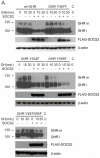The SOCS2 ubiquitin ligase complex regulates growth hormone receptor levels
- PMID: 21980433
- PMCID: PMC3183054
- DOI: 10.1371/journal.pone.0025358
The SOCS2 ubiquitin ligase complex regulates growth hormone receptor levels
Abstract
Growth Hormone is essential for the regulation of growth and the homeostatic control of intermediary metabolism. GH actions are mediated by the Growth Hormone Receptor; a member of the cytokine receptor super family that signals chiefly through the JAK2/STAT5 pathway. Target tissue responsiveness to GH is under regulatory control to avoid excessive and off-target effects upon GHR activation. The suppressor of cytokine signalling 2 (SOCS) is a key regulator of GHR sensitivity. This is clearly shown in mice where the SOCS2 gene has been inactivated, which show 30-40% increase in body length, a phenotype that is dependent on endogenous GH secretion. SOCS2 is a GH-stimulated, STAT5b-regulated gene that acts in a negative feedback loop to downregulate GHR signalling. Since the biochemical basis for these actions is poorly understood, we studied the molecular function of SOCS2. We demonstrated that SOCS2 is part of a multimeric complex with intrinsic ubiquitin ligase activity. Mutational analysis shows that the interaction with Elongin B/C controls SOCS2 protein turnover and affects its molecular activity. Increased GHR levels were observed in livers from SOCS2⁻/⁻ mice and in the absence of SOCS2 in in vitro experiments. We showed that SOCS2 regulates cellular GHR levels through direct ubiquitination and in a proteasomally dependent manner. We also confirmed the importance of the SOCS-box for the proper function of SOCS2. Finally, we identified two phosphotyrosine residues in the GHR to be responsible for the interaction with SOCS2, but only Y487 to account for the effects of SOCS2. The demonstration that SOCS2 is an ubiquitin ligase for the GHR unveils the molecular basis for its physiological actions.
Conflict of interest statement
Figures






Similar articles
-
Crystal structure of the SOCS2-elongin C-elongin B complex defines a prototypical SOCS box ubiquitin ligase.Proc Natl Acad Sci U S A. 2006 May 16;103(20):7637-42. doi: 10.1073/pnas.0601638103. Epub 2006 May 4. Proc Natl Acad Sci U S A. 2006. PMID: 16675548 Free PMC article.
-
A growth hormone receptor SNP promotes lung cancer by impairment of SOCS2-mediated degradation.Oncogene. 2018 Jan 25;37(4):489-501. doi: 10.1038/onc.2017.352. Epub 2017 Oct 2. Oncogene. 2018. PMID: 28967904 Free PMC article.
-
Biophysical studies on interactions and assembly of full-size E3 ubiquitin ligase: suppressor of cytokine signaling 2 (SOCS2)-elongin BC-cullin 5-ring box protein 2 (RBX2).J Biol Chem. 2015 Feb 13;290(7):4178-91. doi: 10.1074/jbc.M114.616664. Epub 2014 Dec 11. J Biol Chem. 2015. PMID: 25505247 Free PMC article.
-
Pulsatility of growth hormone (GH) signalling in liver cells: role of the JAK-STAT5b pathway in GH action.Growth Horm IGF Res. 2000 Apr;10 Suppl B:S1-8. doi: 10.1016/s1096-6374(00)80002-7. Growth Horm IGF Res. 2000. PMID: 10984246 Review.
-
Negative regulation of growth hormone receptor signaling.Mol Endocrinol. 2006 Feb;20(2):241-53. doi: 10.1210/me.2005-0170. Epub 2005 Jul 21. Mol Endocrinol. 2006. PMID: 16037128 Review.
Cited by
-
Suppressor of cytokine signaling 2 (SOCS2) associates with FLT3 and negatively regulates downstream signaling.Mol Oncol. 2013 Jun;7(3):693-703. doi: 10.1016/j.molonc.2013.02.020. Epub 2013 Mar 19. Mol Oncol. 2013. PMID: 23548639 Free PMC article.
-
Exosomes in Food: Health Benefits and Clinical Relevance in Diseases.Adv Nutr. 2020 May 1;11(3):687-696. doi: 10.1093/advances/nmz123. Adv Nutr. 2020. PMID: 31796948 Free PMC article. Review.
-
SOCS proteins in regulation of receptor tyrosine kinase signaling.Cell Mol Life Sci. 2014 Sep;71(17):3297-310. doi: 10.1007/s00018-014-1619-y. Epub 2014 Apr 5. Cell Mol Life Sci. 2014. PMID: 24705897 Free PMC article. Review.
-
Regulation of neurotrophin receptor (Trk) signaling: suppressor of cytokine signaling 2 (SOCS2) is a new player.Front Mol Neurosci. 2014 May 14;7:39. doi: 10.3389/fnmol.2014.00039. eCollection 2014. Front Mol Neurosci. 2014. PMID: 24860421 Free PMC article. Review.
-
The role of suppressors of cytokine signalling in human neoplasms.Mol Biol Int. 2014;2014:630797. doi: 10.1155/2014/630797. Epub 2014 Mar 16. Mol Biol Int. 2014. PMID: 24757565 Free PMC article. Review.
References
-
- Deng L, He K, Wang X, Yang N, Thangavel C, et al. Determinants of growth hormone receptor down-regulation. Mol Endocrinol. 2007;21:1537–1551. - PubMed
-
- Tritos NA, Biller BM. Growth hormone and bone. Curr Opin Endocrinol Diabetes Obes. 2009;16:415–422. - PubMed
-
- Ahmed SF, Farquharson C. The effect of GH and IGF1 on linear growth and skeletal development and their modulation by SOCS proteins. J Endocrinol. 2010;206:249–259. - PubMed
-
- Greenhalgh CJ, Bertolino P, Asa SL, Metcalf D, Corbin JE, et al. Growth enhancement in suppressor of cytokine signaling 2 (SOCS-2)-deficient mice is dependent on signal transducer and activator of transcription 5b (STAT5b). Mol Endocrinol. 2002;16:1394–1406. - PubMed
Publication types
MeSH terms
Substances
Grants and funding
LinkOut - more resources
Full Text Sources
Molecular Biology Databases
Miscellaneous

